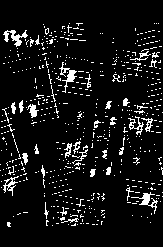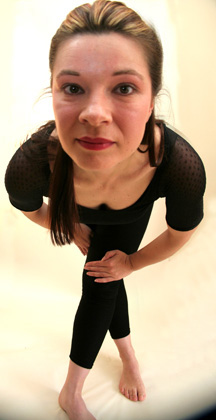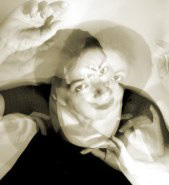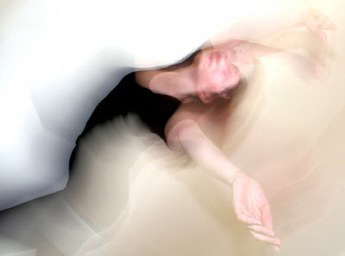
 photo by Matt Jamie
|
RED HEADED
STEPCHILD by Claire Elizabeth Barratt
|
 photo by Matt Jamie
|
In my experience of life as a movement artist, I have begun to realize that movement, especially improvized movement – even more so, improvized movement within the context of Performance Art – REALLY IS the “Red Headed Stepchild” of the arts that no one quite knows what to do with! WELL MEANING RELATIVES Many "well meaning relatives" will attempt, somewhat awkwardly, to take her under their wing: Uncle Gothic Rock wants to sleaze her into some bizarre S&M type of freak show. Aunties Avant Garde and Intelligencia like to notice the correlation to an established, recognized yet obscure dance form, such as “Butoh”. The Classical Cousins desperately want to think the best of her – really they do. But her inability to produce something recognizable, concrete, a narrative, a pretty picture – something they can grasp as truth – leaves them highly suspicious. Brother Open Jam Circle accuses her of being “stuck up” and “alienating herself” when he's just trying to be nice and include her in the party. “Maybe you'll meet someone who can help you out.” Hip Hop lives next door. He's not related. He gets it. He thinks she's kinda cool. Doesn't care that much but he'll be around if she wants to hang out. But Grandmother Ancient Ritual (she has Alzheimer's and sees with the eyes of a child) is fascinated. She holds a seance and calls on history's tribal elders. They ordain the Red Headed Stepchild as a Prophet and a Visionary. They claim her as a milestone of evolution. They warn her that her journey is a lonely one. (Should she pioneer on? Go back to school to study for a more lucrative career? Devote her life to a kind, compassionate occupation with animals or poor, starving children?) VENUES & SITE SPECIFIC MOVEMENT “......But this is not a good space for dance.” “......We don't do dance performances here..........” “.... I can put you in touch with some local dancers who know about dance venues in town.........” These are typical responses I get when approaching many venues I want to perform in. Most assume that I am a “dancer” who requires a good “dance space” - ie. big, open space with smooth, wooden sprung floors, high ceilings etc. That's all fine and good, especially if you have a set “piece” that needs a “stage” - like a blank canvas on which to present your work (which I occasionally do.) But for improvized movement, this kind of blank, open “perfect” dance space makes me feel quite agoraphobic! There's nothing there for me to converse with. I need to have a relationship with the environment, and the more eccentric it is, the more interesting that relationship will be. I enjoy performing in a place that quite literally “shapes” the movement. The rough, splintery floor of an old warehouse, the moldy couch in the corner of the coffee shop, the books and knick-knacks on the shelves, the pin-ball machine in the back room of the bar, balancing on a rickety table, being framed by an open doorway, a staircase, a closet, a passageway. This is the true definition of “Site Specific,” that is... ...the performance could not be the same in any other location. MUSICIANS & MOVEMENT IN SOUND Believe it or not, there are actually musicians who are quite uncomfortable with dance. As open-minded as they would like to think they are or appear to be! I get the impression from some musicians that they think dance is not as “important” as music. That dance is not to be taken “seriously”. OR that they are intimidated by it. Some state that they “don't really know how to play for dance”, or that it's a “distraction from the music”. To me, (within this type of collaboration)... DANCE IS AN INSTRUMENT! In the same way as is a voice, a saxophone, a guitar, a piano. Movement is an equal voice in this composition in real time. It is not a solo being “accompanied” by the music. Neither is it a puppet “interpreting” the sound. Why would it be a “distraction” any more than rhythm is a distraction from melody? Rhythm and Melody are commonly accepted as partners. So it is the same with Movement and Sound. Another common misgiving is that a dancer needs a catchy tune or rhythm to dance to. NOT SO. Movement is just as capable of exploring abstractions; concepts, moods, colors, textures or of by-passing any cerebral context altogether and plugging into the socket of the moment. INSTALLATION & MOVEMENT AS VISUAL ART Exploring the context of Movement as Visual Art, I have developed a movement style I call “Motion Sculpture”. It is, quite literally, the human form as a slow-motion sculpture piece. Incrementally shifting shape. It is presented as installation, often lasting for several hours. (My definition of installation being: To create or become part of a (conceptually ) eternal environment; wherein the audience is free to view / experience in whatever manner and for whatever length of time they wish.) Yet again, I am misunderstood! Because these sculptures are made of “real” people, there is the automatic assumption that it is “dance”. And with this pre-conceived notion of dance comes the expectation of such things as choreography, exciting moves, variety and entertainment. When one complains about the lack of such, it is rather like complaining about the lack of action in a Zen Garden! Which leads on to the next variety of individual who does not know where to put the Red Headed Stepchild....
For more information about Claire Elizabeth Barratt
|
